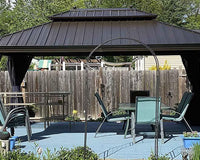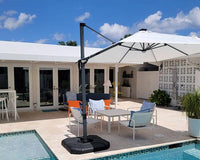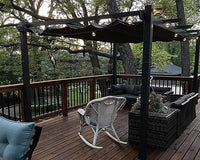Quick Answer
The quick answer is absolutely! While they're designed for backyards, patio umbrellas can totally work for beach days too. The main thing is to anchor your patio umbrella well in the sand since it's heavier than a beach version. But once it's securely in place, you've got ample coverage from the canopy to escape the sun. Patio umbrellas are built sturdy, so with proper precautions they can stand up to beach conditions just fine. And their size means more shade for everyone to fit under!
While specialized beach umbrellas do exist, don't hesitate to bring your trusty patio umbrella to the seaside. Just focus on keeping it properly planted into the sand. Then it's nothing but sunny relaxation under its spacious canopy!
Introduction
Heading to the beach on a sunny day means you need serious shade. You may wonder if your patio umbrella at home could work instead of buying a new beach-specific one. Is lugging that big ol' umbrella to the sand a smart move or more trouble than it's worth?
In this article, we'll look at how patio and beach umbrellas differ, how to get one to the shore if you choose to, and whether it's truly practical. We'll unpack the pros and cons of taking your backyard umbrella on a seaside adventure. Read on and see if your patio umbrella has what it takes for beach relaxation!

Comparing Patio and Beach Umbrellas
When packing for a beach trip, it helps to know the key differences between patio and beach umbrellas so you bring the right one.
Patio Umbrellas - Built for Backyards
Patio umbrellas are designed for backyard use and made of heavier materials to provide stability:
- Often 6-13 feet wide and can weigh 15-30 pounds for ample backyard coverage
- Sturdy 1-2 inch diameter poles usually made of wood, aluminum or steel to stand securely on patios
- Wide bases require 25-50 lbs to keep umbrella anchored in place
- Polyester, olefin or canvas canopies handle backyard conditions
- Mostly manual operation using crank or pulley system to raise and lower
Beach Umbrellas - Made for Seaside Conditions
Beach umbrellas are engineered with portability and oceanfront durability in mind:
- Typically 5-7 feet wide and weigh just 5-12 lbs for easy transport
- Narrow 3/4 - 1 inch poles made of rust-resistant aluminum alloy
- Sharp tips dig 10-12 inches into sand for added stability
- Nylon and polyester canopies have UV coatings and vents to handle sun, wind and saltwater
- Push-up operation utilizes lever action to open and close quickly
While patio and beach umbrellas serve the same sun protection purpose, their designs suit different environments. Understanding their specialized features ensures you pick the right umbrella for your needs.
Taking Your Patio Umbrella on a Beach Trip
You've decided to take your patio umbrella on a beach trip. Awesome! But how do you get that big, bulky thing to the sand without a major hassle? Here are some tips for making it more portable:
- Check the Weight - Patio umbrellas can be heavy. Before committing, see if you can lift and carry yours comfortably alone or if you'll need help. Don't want to strain yourself? Use a beach cart.
- Opt for a Detachable Pole - Many patio umbrellas have poles that detach for easier transport. Snap it off and pack the parts separately. Much lighter!
- Use a Carrying Case - Special cases with shoulder straps make lugging your umbrella way more manageable. Bonus - they protect the canopy!
- Learn to Collapse It - Know how to properly fold down your umbrella before beach day. Struggling with one that won't budge is no fun once you're there!
- Pack a Large Bag - A duffel or special umbrella case makes carrying awkwardly-shaped umbrellas easier and safer during transport.
With some prep, you can get your patio umbrella to the beach without throwing out your back. Then focus on the fun and sun protection!
Anchoring Your Patio Umbrella Securely at the Beach
Transporting your patio umbrella to the beach is one thing. Making sure it stays put is a whole other challenge with the wind and sand. Here are some tips for keeping it anchored properly:
Use a Specialized Sand Anchor
Patio umbrella bases are meant for flat surfaces, not digging into sand. Opt for an auger-style beach umbrella anchor that screws down 12-18 inches, or a spiral corkscrew stake that burrows deep into the sand for a sturdy hold.
Try a DIY Bucket Anchor
An easy makeshift sand anchor is filling a bucket with 15-20 lbs of wet or dry sand. Nestle your umbrella pole in the bucket and the weight will keep it from blowing away in most winds.
Secure It Well Before Relaxing
Safety first! Give your anchored umbrella a forceful back-and-forth rock test, tugging on the canopy. If it shifts easily, it needs more stabilizing weight or screw anchors. A flying umbrella can seriously hurt someone.
Set Up Behind the Tide Line
For maximum stability, plant your umbrella above the high tide line to utilize the firmer packed sand. Wet, looser sand closer to the tide is more challenging for anchors to grip.
With the right anchoring gear and techniques, your patio umbrella can stand strong at the beach just like in your backyard. Sit back in your chair and relax under the shade knowing your umbrella isn't going anywhere!
Maximizing Shade and UV Protection Under Your Patio Umbrella
Now that your patio umbrella is planted on the sand, let's make sure you get ample UV protection and cooling shade from it.
Check the UPF Rating
Like SPF for sunscreen, UPF indicates how much UV radiation a fabric blocks. Aim for a rating of 30+ like quality beach umbrellas have. This data should be tagged on the umbrella.
Enjoy the Size
A benefit of patio umbrellas is their large size, which provides more expansive shade than beach versions. But still check the UPF rating, as coverage alone doesn't guarantee UV blocking.
Adjust the Angle
Unlike your fixed backyard position, the umbrella needs angling as the sun moves across the sky to optimize shade. Some tilt easily, others require manual adjusting. Just stay on top of it!
With a high UPF rating, ample coverage and tilting adjustments, you can stay chill in the shade knowing your skin is safe. Now focus on building epic sandcastles and enjoying drinks in the oasis your patio umbrella provides.
Keeping Your Patio Umbrella in Top Shape at the Beach
The beach environment can be tough on patio umbrellas not designed for ocean use. But with care and the right materials, your umbrella can handle occasional beach trips just fine.
- Watch Out for Wind and Saltwater: The constant wind and salty air causes wear and tear. Look for canopies made of fade and mildew-resistant fabrics like polyester that won't get damaged by saltwater and UV rays. Rust-resistant aluminum or steel hubs and frames hold up better than iron or wood.
- Battling Sand Damage: Beach umbrellas have vents to prevent wind damage and let sand fall through. Patio versions tend to trap sand which can abrade and grind down moving joints. At the end of each day, give your umbrella a good shaking out and use a soft brush to clear crevices.
- Post-Beach Care: Don't just close up your sandy, salt-covered umbrella! When you get home, rinse off all residues with a hose. Let the canopy and frame dry completely before storing to prevent mildew and rust. Keep in a dry spot out of sunlight.
With the right prep work and materials, occasional beach trips won't ruin your patio umbrella. But be ready for more wear versus using it only on your patio or deck. Proper care and cleaning make all the difference in its longevity.
Chill Under a Market Umbrella: Your Go-To Shade for Beachside Hangouts
Looking for something cool and shady for your beach house or oceanside café? Check out market umbrellas! They're not your average umbrella: they've got a unique look with their shaped canopies and they're tough enough to handle a sea breeze.
Why You'll Love Market Umbrellas by the Sea
- Block the Rays: These umbrellas often come with UV-blocking fabric, so you can hang out under them without fretting over sunburns. Plus, they use tough fabric that doesn't fade fast in the salty air, keeping your space looking fresh.
- Move That Shade Around: Got a market umbrella with a tilt option? Perfect for chasing the shade as the sun does its daily sky dance. Just hit the button and adjust-no fuss, no muss.
- Snazzy Styles: Want to jazz up your outdoor area? Market umbrellas come in designs that can do just that. Picture one with cute tassels waving in the wind-it's like your little piece of paradise.
- Built to Last: Seaside living is awesome but rough on gear. That's why some market umbrellas are made with solid frames and ribs that won't let you down. They even come in weather-resistant materials like fiberglass, so rust won't crash your party.
Who Should Grab a Market Umbrella?
- Beach House Owners: If your doorstep is basically in the sand, a market umbrella is essential for your patio or poolside. It's all about turning your outdoor space into a chill zone for eating, kicking back, or diving into a good book with the ocean air for company.
- Coastal Shop Owners: Run a little spot by the water, like a café or boutique? Pop a few market umbrellas over your outdoor seats. They give your customers a break from the sun and boost your spot's vibe. Guests will love lounging a bit longer, sipping, and shopping at your breezy haven.
Key Takeaways
Is dragging your patio umbrella to the shore worth it? That's up to you! Go for it if you don't mind the work for extra shade. Otherwise, portable beach tents are fuss-free shelters. Either way, lather on sunscreen and bring cold drinks - you're set for seaside chilling!




